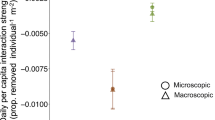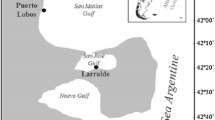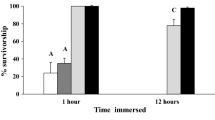Abstract
Small herbivores are abundant on large marine macrophytes, but their impact on their hosts is poorly understood relative to large grazers such as urchins and fish. To limit the risks of predation, many marine mesograzers live within nests or burrows, potentially causing more damage to plants than predicted from consumption alone. To test whether the growth of large primary producers can be affected by modification of plant structures by small herbivores, we quantified the effect of the nest-building amphipod Pseudopleonexes lessoniae on blades of the giant kelp, Macrocystis pyrifera in New Zealand. Amphipods create their nests by rolling the blade margin in close proximity to the meristem. Blades with nests were 40% shorter than blades lacking nests and reduced in area by 55%. We examined the composition of amphipods inhabiting each nest to assess the temporal persistence of grazer aggregations. Nests were occupied by a single female or male–female pairs, and their newly hatched offspring. Analysis of offspring size distributions suggested that offspring dispersed from the maternal nest and did not remain to breed themselves. By concentrating physical damage and feeding on valuable tissues, these results indicate that even low numbers of small herbivores can cause localized impacts on the morphology and size of fast-growing algal blades. Predicting the consequences of this damage on larger scales will require understanding the spatial and temporal distribution of amphipod nests on giant kelp.



Similar content being viewed by others
References
Appadoo C, Myers AA (2002) Observations on the tube-building behaviour of the marine amphipod Cymadusa filosa Savigny (Crustacea: Ampithoidae). Journal of Natural History 37:2151–2164
Arnold KE, Manley SL (1986) Carbon allocation in Macrocystis pyrifera (Phaeophyta): intrinsic variability in photosynthesis and respiration. J Phycol 21:154–167
Bell JE, Bishop MJ, Taylor RB, Williamson JE (2014) Facilitation cascade maintains a kelp community. Mar Ecol Prog Ser 501:1–10
Campbell AH, Vergés A, Steinberg PD (2014) Demographic consequences of disease in a habitat-forming seaweed and impacts on interactions between natural enemies. Ecology 95:142–152
Cerda O, Karsten U, Rothäusler E, Tala F, Thiel M (2009) Compensatory growth of the kelp Macrocystis integrifolia (Phaeophyceae, Laminariales) against grazing of Peramphithoe femorata (Amphipoda, Ampithoidae) in northern-central Chile. J Exp Mar Biol Ecol 377:61–67
Cerda O, Hinojosa IA, Thiel M (2010) Nest-building behavior by the amphipod Peramphithoe femorata (Krøyer) on the kelp Macrocystis pyrifera (Linnaeus) C. Agardh from northern-central Chile. Biol Bull 218:248–258
Chess JR (1993) Effects of the stipe-boring amphipod Peramphithoe stypotrupetes (Corophioidea: Ampithoidae) and grazing gastropods on the kelp Laminaria setchelli. J Crustac Biol 13:638–646
Conlan KE (1982) Revision of the gammaridean amphipod family Ampithoidae using numerical analytical methods. Can J Zool 60:2015–2027
Conlan KE, Chess JR (1992) Phylogeny and ecology of a kelp-boring amphipod, Peramphithoe stypotrupetes, new species (Corophioidea: Ampithoidae). J Crustac Biol 12:410–442
Cronin G (2001) Resource allocation in seaweeds and marine invertebrates: chemical defense patterns in relation to defense theories. In: McClintock JB, Baker BJ (eds) Marine chemical ecology. CRC Press, Boca Raton, pp 325–353
Davenport AC, Anderson TW (2007) Positive indirect effects of reef fishes on kelp performance: the importance of mesograzers. Ecology 88:1548–1561
Doak DF (1992) Lifetime impacts of herbivory for a perennial plant. Ecology 73:2086–2099
Duffy JE, Hay ME (2000) Strong impacts of grazing amphipods on the organization of a benthic community. Ecol Monogr 70:237–263
Fukui A (2001) Indirect interactions mediated by leaf shelters in animal–plant communities. Popul Ecol 43:31–40
Fukui A, Murakami M, Konno K, Nakamura M, Ohgushi T (2002) A leaf-rolling caterpillar improves leaf quality. Entomol Sci 5:263–266
Graham MH (2002) Prolonged reproductive consequences of short-term biomass loss in seaweeds. Mar Biol 140:901–911
Griffiths CL (1979) A redescription of the kelp curler Ampithoe humeralis (Crustacea, Amphipoda) from South Africa and its relationship to Macropisthopous. Ann S Afr Museum 79:131–138
Gutow L, Long JD, Cerda O, Hinojosa IA, Rothäusler E, Tala F, Thiel M (2012) Herbivorous amphipods inhabit protective microhabitats within thalli of giant kelp Macrocystis pyrifera. Mar Biol 159:141–149
Horton T, De Broyer C, Costello M, Bellan-Santini D (2017) Ampithoidae Boeck, 1871. In: Horton T, Lowry J, De Broyer C, Bellan-Santini D, Coleman CO, Corbari L, Daneliya M, Dauvin J-C, Fišer C, Gasca R, Grabowski M, Guerra-García JM, Hendrycks E, Hughes L, Jaume D, Jazdzewski K, Kim Y-H, King R, Krapp-Schickel T, LeCroy S, Lörz A-N, Mamos T, Senna AR, Serejo C, Sket B, Souza-Filho JF, Tandberg AH, Thomas J, Thurston M, Vader W, Väinölä R, Vonk R, White K, Zeidler W (eds) World Amphipoda Database Accessed through: World Register of Marine Species. http://marinespecies.org/aphia.php?p=taxdetails&id=101366. Accessed 12 Dec 2017
Hurley DE (1954) Studies on the New Zealand amphipodan fauna no. 5. Pleonexes lessoniae a new species of the family Amphithoidae. Trans R Soc N Z 81:619–626
Johnson CR, Mann KH (1986) The importance of plant defence abilities to the structure of subtidal seaweed communities: the kelp Laminaria longicruris de la Pylaie survives grazing by the snail Lacuna vincta (Montagu) at high population densities. J Exp Mar Biol Ecol 97:231–267
Jones LG (1971) Studies on selected small herbivorous invertebrates inhabiting Macrocystis canopies and holdfasts in southern California kelp beds. In: North WJ (ed) The biology of giant kelp beds (Macrocystis) in California. Nova Hedwigia (Suppl) 32, pp 343–367
Kozlov MV, Zvereva EL (2017) Background insect herbivory: impacts, patterns and methodology. In: Cánovas F, Lüttge U, Matyssek R (eds) Progress in botany, vol 79. Springer, Cham, pp 313–355
Krumhansl KA, Jl Lee, Scheibling RE (2011) Grazing damage and encrustation by an invasive bryozoan reduce the ability of kelps to withstand breakage by waves. J Exp Mar Biol Ecol 407:12–18
Lill JT, Marquis RJ (2007) Microhabitat manipulation: ecosystem engineering by shelter-building insects. In: Cuddington K, Byers JE, Wilson WG, Hastings A (eds) Ecosystem engineers: plants to protists. Academic Press, New York, pp 107–138
Marquis RJ (1996) Plant architecture, sectoriality and plant tolerance to herbivores. Vegetatio 127:85–97
Mejaes BA, Poore AGB, Thiel M (2015) Crustaceans inhabiting domiciles excavated from macrophytes and stone. In: Thiel M, Watling L (eds) The life styles and feeding biology of the Crustacea volume II in the natural history of the Crustacea series, vol II. Oxford University Press, Oxford, pp 118–144
Molis M, Enge A, Karsten U (2010) Grazing impact of, and indirect interactions between mesograzers associated with kelp (Laminaria digitata). J Phycol 46:76–84
Moore PG, Eastman LB (2015) The tube-dwelling lifestyle in crustaceans and its relation to feeding. In: Thiel M, Watling L (eds) The life styles and feeding biology of the Crustacea volume II in the natural history of the Crustacea series, vol II. Oxford University Press, Oxford, pp 35–77
Muñoz M, Santelices B (1989) Determination of the distribution and abundance of the limpet Scurria scurra on the stipes of the kelp Lessonia nigrescens in Central Chile. Mar Ecol Prog Ser 54:277–285
O’Brien JM, Scheibling RE (2016) Nipped in the bud: mesograzer feeding preference contributes to kelp decline. Ecology 97:1873–1886
Pansch C, Gómez I, Rothäusler E, Véliz K, Thiel M (2008) Species-specific defences strategies of vegetative versus reproductive blades of the Pacific kelps Lessonia nigrescens and Macrocystis integrifolia. Mar Biol 155:51–52
Peart R, Lörz A (2018) Ampithoidae (Crustacea; Amphipoda) from New Zealand. Zookeys 733:25–48
Pérez-Matus A, Shima JS (2010) Density- and trait-mediated effects of fish predators on amphipod grazers: potential indirect benefits for the giant kelp Macrocystis pyrifera. Mar Ecol Prog Ser 417:51–158
Pfister CA, Betcher SP (2018) Climate drivers and animal host use determine kelp performance over decadal scales in the kelp Pleurophycus gardneri (Laminariales, Phaeophyceae). J Phycol 54:1–11
Poore AGB (2005) Scales of dispersal among hosts in a herbivorous marine amphipod. Austral Ecol 30:219–228
Poore AGB, Lowry JK (1997) New ampithoid amphipods from Port Jackson, New South Wales, Australia (Crustacea: Amphipoda: Ampithoidae). Invertebr Taxon 11:897–941
Poore AGB, Hill NA, Sotka EE (2008) Phylogenetic and geographic variation in host breadth and composition by herbivorous amphipods in the family Ampithoidae. Evolution 62:21–38
Poore AGB, Campbell AH, Coleman RA, Edgar GJ, Jormalainen V, Reynolds PL, Sotka EE, Stachowicz JJ, Taylor RB, Vanderklift MA, Duffy JE (2012) Global patterns in the impact of marine herbivores on benthic primary producers. Ecol Lett 15:912–922
Poore AGB, Gutow L, Pantoja JF, Tala F, Madariaga DJ, Thiel M (2014) Major consequences of minor damage: impacts of small grazers on fast-growing kelps. Oecologia 174:789–801
Reed DC (1987) Factors affecting the production of sporophylls in the giant kelp Macrocystis pyrifera (L.) C. Ag. J Exp Mar Biol Ecol 113:61–69
Schiel DR, Foster MS (2015) The biology and ecology of giant kelp forests. University of California Press, Oakland
Sliwinski M, Sigmon E (2013) Why do leaf-tying caterpillars abandon their leaf ties? Peer J 1:e173
Stout MJ, Thaler JS, Thomma BPHJ (2006) Plant-mediated interactions between pathogenic microorganisms and herbivorous arthropods. Annu Rev Entomol 51:663–689
Taylor RB (1998) Short-term dynamics of a seaweed epifaunal assemblage. J Exp Mar Biol Ecol 227:67–82
R Core Team (2017) R: a language and environment for statistical computing. R Foundation for Statistical Computing, Vienna, Austria. https://www.R-project.org/. Accessed 30 June 2018
Tegner MJ, Dayton PK (1987) El Niño effects on southern California kelp forest communities. Adv Ecol Res 17:243–279
Thiel M (2003) Reproductive biology of Limnoria chilensis: another boring peracarid species with extended parental care. J Nat Hist 37:1713–1726
Toth G, Pavia H (2007) Induced herbivore resistance in seaweeds: a meta-analysis. J Ecol 95:425–434
Zimmerman RC, Kremer JN (1986) In situ growth and chemical composition of the giant kelp, Macrocystis pyrifera: response to temporal changes in ambient nutrient availability. Mar Ecol Prog Ser 27:277–285
Acknowledgements
We are very grateful to R. Taylor who hosted MT during measurements of amphipods at Leigh Marine Lab, and to V. Villalobos for help with image analysis. The NIWA Invertebrate Collection team is thanked for curation of the amphipod material. We thank P. Gagnon, S. Hamilton and one anonymous reviewer for comments that have improved this manuscript.
Funding
Data evaluation and manuscript writing were done during a research stay by LG (financed by AWI) and AP (with funding support from FONDECYT Grant 1161383).
Author information
Authors and Affiliations
Contributions
MT conceived the study. MT and AL conducted the field sampling and laboratory measurements. AP analysed the data and led the writing of the manuscript.
Corresponding author
Ethics declarations
Conflict of interest
All authors declare that they have no conflicts of interest.
Ethical approval
All applicable international, national, and/or institutional guidelines for the care and use of animals were followed.
Additional information
Responsible Editor: P. Gagnon.
Reviewed by S. Hamilton and an undisclosed expert.
Electronic supplementary material
Below is the link to the electronic supplementary material.
Rights and permissions
About this article
Cite this article
Poore, A.G.B., Gutow, L., Lörz, AN. et al. Nest building by a small mesograzer limits blade size of the giant kelp Macrocystis pyrifera. Mar Biol 165, 184 (2018). https://doi.org/10.1007/s00227-018-3444-6
Received:
Accepted:
Published:
DOI: https://doi.org/10.1007/s00227-018-3444-6




